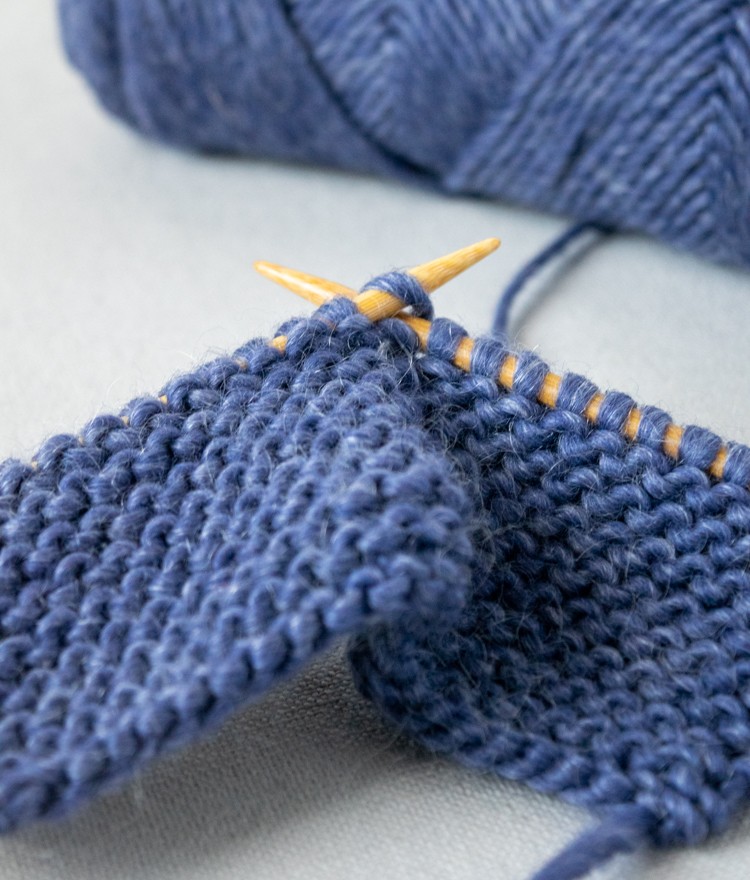Are you a beginner knitter? Or ready to graduate to the next level? Well this is what you need to knit: all the tools and supplies you need to get started as a beginner, and what you need when you are ready to move up towards expert.
I’ve been knitting for a while now. Let’s just say I started at a time when I thought huge baggy sweaters looked great on me, and now that look has come back around (I’m not going for it this time).
I have tried so many tools and accessories, and of course I have strong opinions about what you need and what you don’t, what works and what doesn’t. I’ve put together a list of some of my favorite knitting supplies and notions on my Etsy profile, so you can see a lot of different options all in one place.
Don’t feel like you need to buy everything new though! Try your local thrift store or eBay for used tools and notions, or even post on NextDoor or Facebook and see if anyone has stuff lying around they aren’t using.
Also, support your local yarn store (LYS)! Many of the small shops now have excellent online stores so you don’t even need to live nearby or go to the brick and mortar store.
Be sure to check out all of my knitting projects. If you are still pretty new but feel good casting on and knitting, try the No Purl Scarf — it’s a very simple stitch pattern but the results are beautiful and sophisticated looking. If you are ready to try double-pointed needles and knitting in the round, try the Rainbow Beanie or the Fingerless Gloves pattern.
What You Need: The Basics
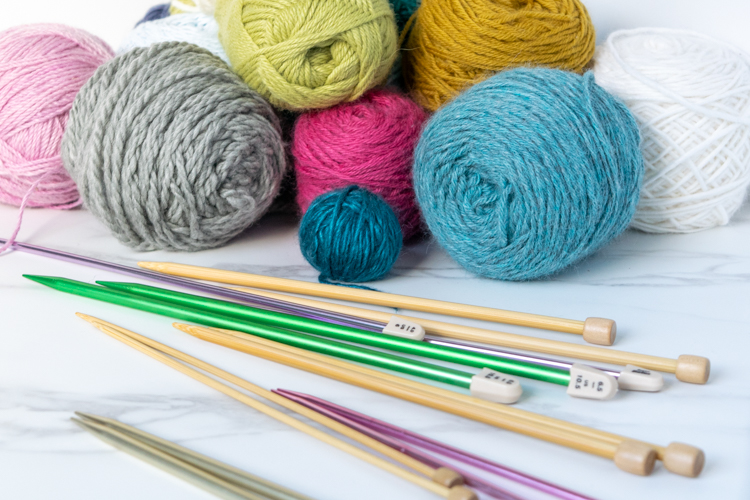
These are the things that every knitter needs when starting out.
Yarn
The world of yarn is exhilarating and overwhelming and vast. It comes in different weights! And fibers! And how much do you need?
For beginners, keep it simple: Lamb’s Pride bulky yarn is the best choice if you are just learning to knit. (You can see it in the image at the top of this post.) It’s a high quality, affordable, 100% natural fibers, nice and thick, and single-ply so it won’t split easily. It is the yarn that Waldorf students learn to knit with when they are just starting in first grade, and it is widely available at local yarn stores. And it comes in all the colors. I’ll say it again, support your local yarn store!!
If you don’t mind using acrylic yarn, you can use something like Lion Brand Hometown. It’s nice and thick, and very inexpensive.
Of everything on this list, once you graduate from newbie knitter, yarn is the one thing worth spending money on. Think about it. Yes, it’s nice to work with well-made tools. But the thing you are knitting will probably be around for years if not decades, worn or used by you or someone you care about, and even passed down as a family treasure. Don’t you want it to be as nice as possible? If you are just making washcloths, then definitely get some cheap cotton from the craft store. Otherwise, spend as much as you can afford. And believe me, the sky’s the limit on yarn…
Knitting Needles
Needles also come in lots of flavors: straight, circular, double-pointed, bamboo, wood, aluminum, plastic. And then of course sizes: US sizes, millimeters. It’s a lot to take in.
When you are just starting, stick with the straight needles made from bamboo, around 9 to 10 inches long. You don’t need the other kinds of needles until you are more advanced, and the texture of the bamboo keeps the yarn from sliding off easily resulting in dropped stitches.
Needle size is shown in either US size or millimeters. The pattern or yarn you are using will specify which size needles you need to use. Most patterns will ask you to check your gauge by knitting a swatch, and you may need to go up or down a size or two to get it right.
Once you have been knitting for a bit, you can try the metal needles and see if you like their feel (I don’t recommend the plastic ones unless you can get them for free). I use metal and bamboo, depending on the project, but I especially love the Addi Turbo circular needles even for projects that I’m knitting flat. These come in different lengths as well as sizes, so you will end up with lots of them. I’ve found great prices for them on eBay.
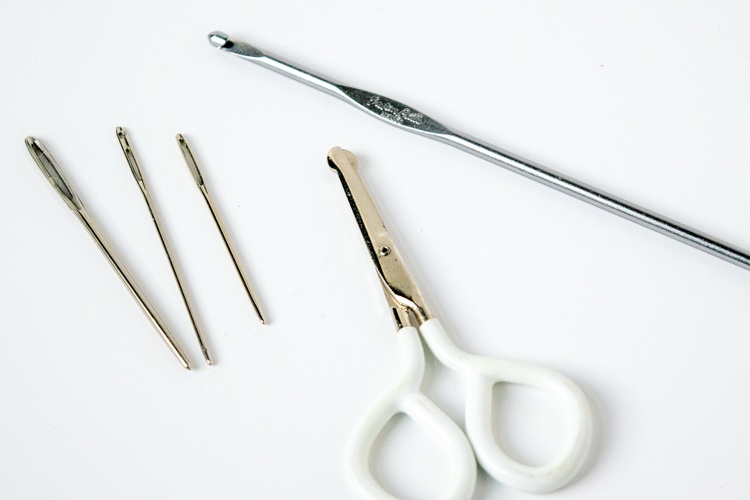
Scissors
Any small scissors or snips will do. I use baby nail scissors, little sewing scissors, embroidery scissors… I am currently in love with these little snips though. So cute! So tiny!
Darning Needles/Yarn Needles
These are blunt-tipped needles with a large eye that are used to sew together seams or sew in yarn tails.
Tape Measure
Any craft or sewing tape measure will work. I like ones with inches and centimeters. The little retractable ones are easy to fit in a pouch with your other tools.
Repair Hook or Stitch Fixer
They make special tools for this, or you can just use a size G (4.25 mm) crochet hook, as I have always done. Technically these aren’t essential, but when you drop a stitch and are trying to grab that loop with your fingers or a knitting needle, well, it makes life a lot easier.
I keep these stashed around for emergencies: one in my bedside drawer, one in the car, one in my knitting notions kit. You never know when you are going to drop a stitch.
What You Need: Intermediate to Expert
When you are no longer a newbie and start knitting more complicated patterns, you will need to get a few more tools. Don’t worry about buying them all at once — each pattern will specify exactly what you need — except for the knitting gauge. You do need that for most projects.
Knitting Gauge
A knitting gauge is a measuring tool that combines a needle/hook gauge and a stitch gauge. A needle gauge is a series of holes so you can check the size of your needles (and crochet hooks) (Some needles are labeled well and some aren’t.) A stitch gauge allows you to check how many rows and stitches you have in a measured area. Most patterns will give you the gauge (e.g. 20 stitches and 48 rows = 4 inches in garter stitch), and you can (should) knit a swatch with the needles and yarn you plan to use to check that you get the same measurements.
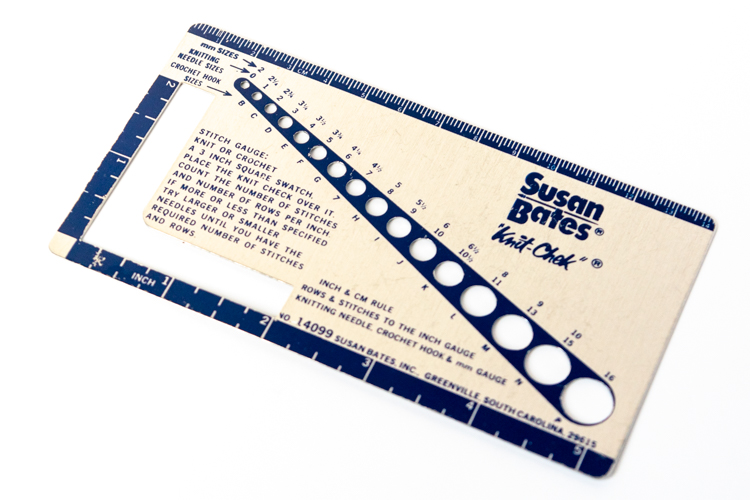
Stitch Markers
Markers are used to remind you of changes in your pattern or help you keep count of stitches, and there are lots of choices. I have used these Clover Split Ring Markers for many years and find they work well. Recently I got some of these bulb safety pins to use as markers and really like how they work too.
I prefer the more minimalist markers — bulky things dangling from my knitting really bother me. And I don’t like to spend money on them because I lose them all the time in the sofa, the car, the airplane…
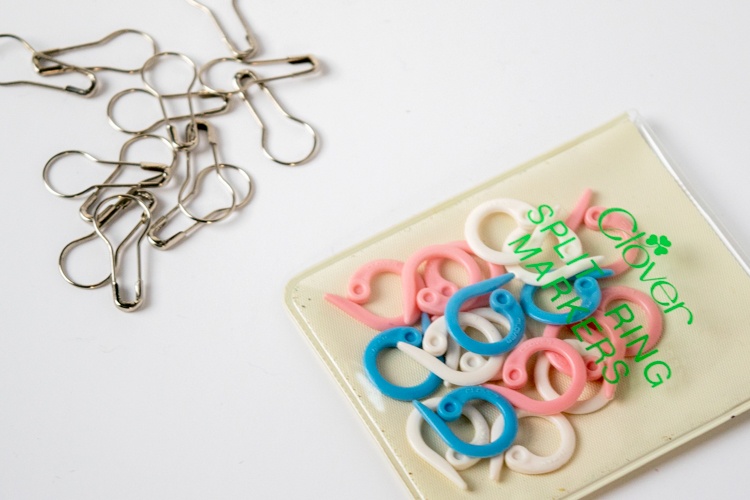
Stitch Holders
Some patterns require you to set aside a group of stitches while working on another group, and that’s what stitch holders are for. You will need different sizes in case you need to hold a lot of stitches or just a few.
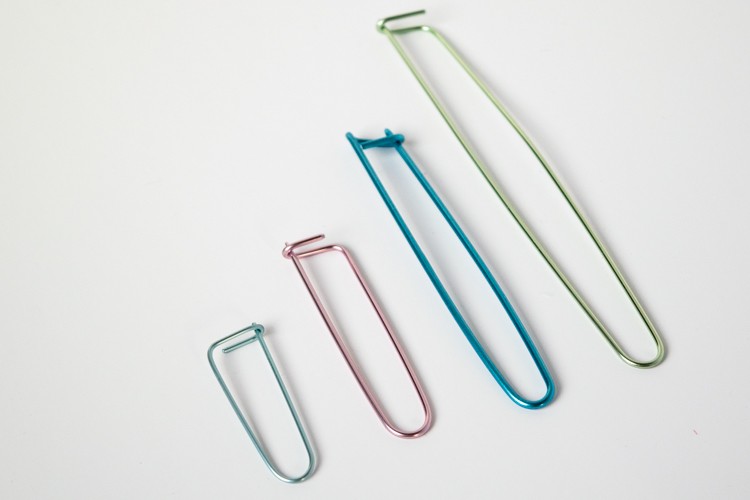
Circular needles
Circular needles are for knitting things in the round like hats, cowls, sometime sweaters — it just depends on the pattern. Every pattern will tell you if you need circular needles and what size and length to get.
They come in bamboo and metal. I like the Addi Turbos, but the Clover Takumi bamboo ones are also good.
I like to use circular needles for knitting large things like sweaters and blankets even if I’m not knitting in the round because I don’t like using long straight needles. I find the circular ones hold all of the stitches well with plenty of room, and they are less awkward to knit with.
Double-pointed needles
Double-pointed needles are for knitting things in the round that have a small circumference, like mittens or baby hats. You can slide the stitches on the needle and knit from both ends so you don’t have to stretch the stitches. Most are made out of bamboo or wood, but you can find them made out of metal. I prefer the bamboo because the stitches don’t slide off as easily.
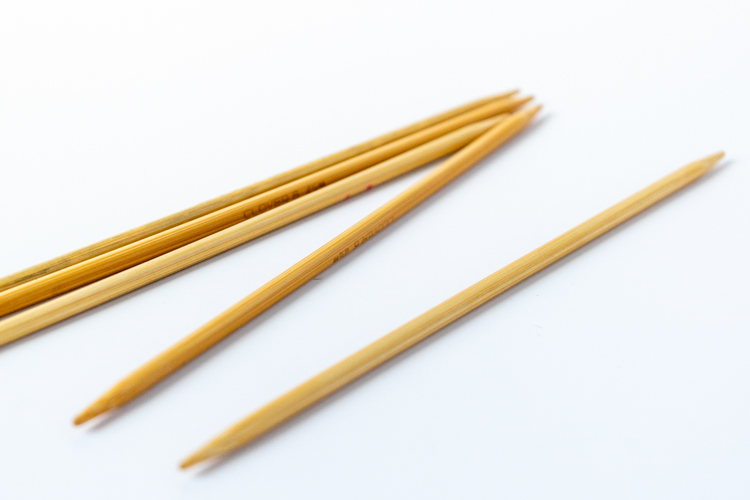
Cable Needles
Cable needles are funny-shaped things that are used to hold stitches when you are knitting a pattern with, you guessed it, cables. If you don’t ever knit cables, you won’t need these.
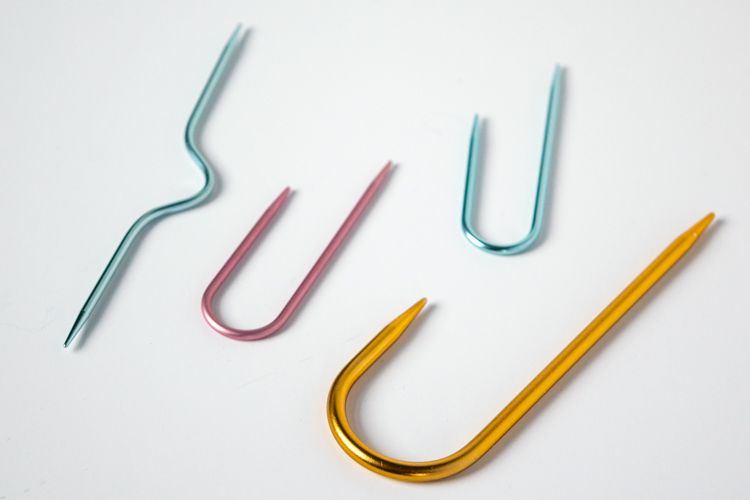
What You Need: Organizing
Now you have a whole bunch of knitting supplies and projects that you need to keep tidy.
Project Bags
These are just soft cloth bags, usually drawstring, to keep your yarn, pattern, and other assorted bits together for one specific project. You can buy cute ones, or make them yourself, or repurpose something you already have: shoe bags, cloth produce bags, the cute bag that your Target sheet set came in… It’s nice to have a bunch of these in different sizes for all. of. the. projects.
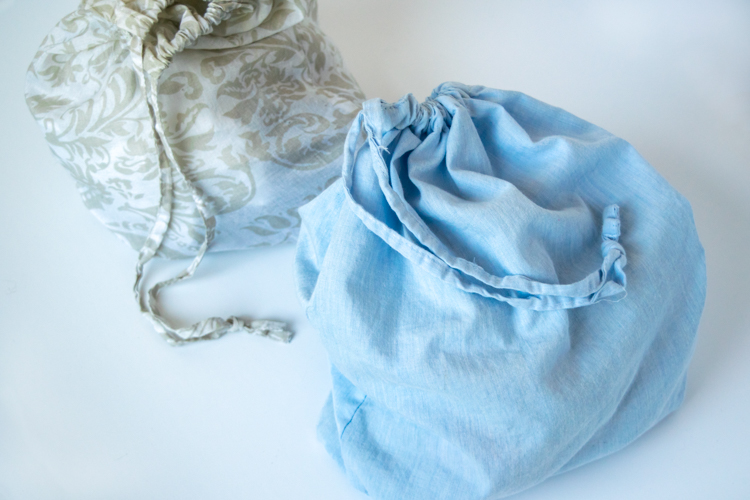
Notions Pouch
You are going to need a little bag to keep all of your knitting tools in! I like pouches that are transparent — saves hunting around for things. You can buy something suitable at the drugstore or the office supply store, or buy something cute on Etsy, or a mesh pouch on Amazon. Something about the size of a small makeup bag or large pencil case is good.
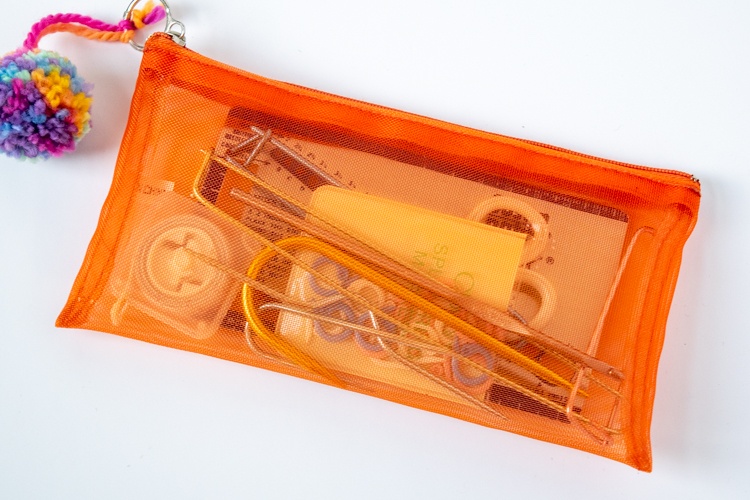
Needle Organizers
Once you have been knitting for a while, you will start to have quite a few needles. For straight and double-pointed needles, something like this case works very well. You can also find gorgeous needle cases on Etsy.
Circular needles are a little harder, and I struggled with what to do with them for years. Straight and double-pointed needles are all pretty well marked with their size, circular needles not so much (why??). Every time I started a project I found myself going through all of them with my trusty gauge and tape measure. Ugh.
Eventually, I decided that the packages they arrive in are great for storing them, and I bought zip top bags for the ones I didn’t have the package for. I labeled all of them with size and length and keep them in a bag all neatly in order. I don’t love the plastic bag solution, but it is so easy to find what I need now.
I like the idea of hanging needle holders as well, and they would be cute if you have a dedicated craft space or room.
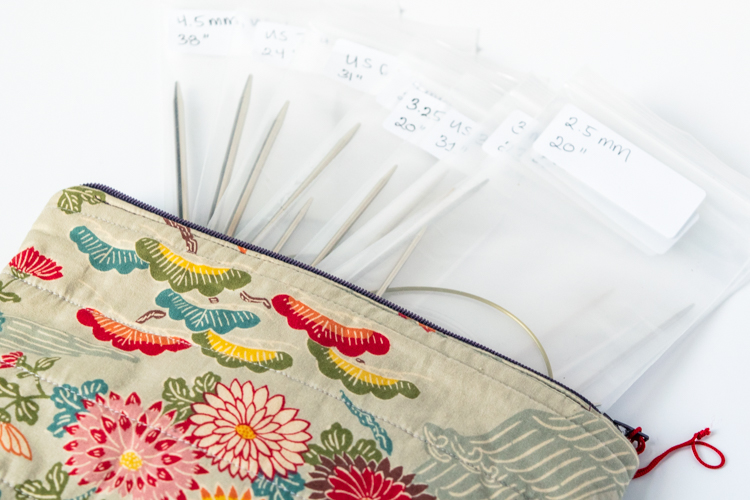
Pattern Protectors
I like to put my patterns in a sheet protector so they don’t get crumpled up in my bags, especially for bigger projects that I’m going to be working on for a while. If it’s a printed pattern or one from a book, then I make a copy first.
I also circle or highlight important details in the pattern, and make notes in the margins as I go along. Then when you are finished with the project you can put the pattern in a binder for the next time you need it.
What You Don’t Need (But is Nice to Have)
Needle Protectors
For years I used these things called point protectors on my needles and they drove me crazy! They fall off constantly in my bag and then what’s the point? Someone at my LYS showed my these ingenious needle protectors and I am hooked. You really only need them for circular needles, but they never fall off, so your stitches never fall off. Perfect.
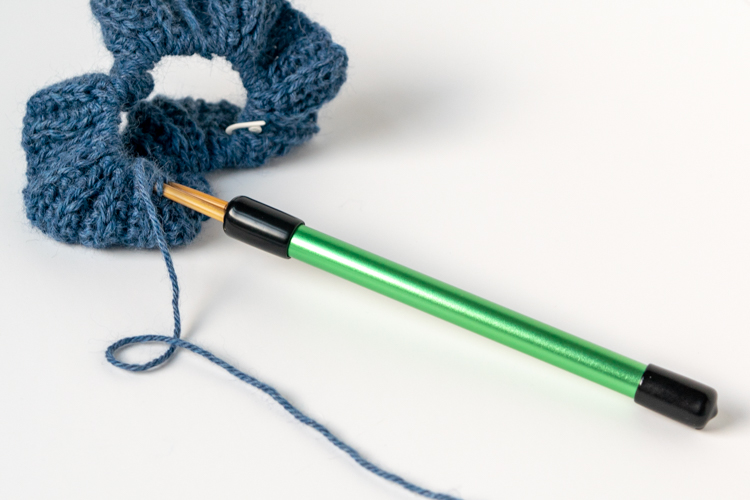
Row counter
I have only used one of these long ago when I was knitting sweaters with complicated patterns, but some knitters love them. They come in digital and analog versions, and there is also an app called Row Counter that looks interesting.
Ball Winder & Swift
A swift is used to hold a hank of yarn while it is being wound into a ball, usually by a ball winder. The ball winder will turn your hank into a center-pull ball that is easy to knit from and won’t tangle. If you have ever bought yarn in a hank at a yarn shop, they probably asked you if you wanted it wound into a ball.
You can get the basic version of both for a small investment (this is what I have used for years) or invest in very beautiful, hand-crafted, wood ball winders and swifts that would look amazing in your craft room.
Why would you want your own instead of just having it wound at the yarn shop? A few reasons: it is better to store yarn in hanks, so you might not want to have it wound into balls at the store. You can buy yarn online in hanks and wind it yourself at home. And you can recycle yarn, either from your own past projects, or store-bought knits, and easily wind it into hanks or balls. I told you this was next-level.
And we will end with Ryan Gosling. Because he is always so supportive.
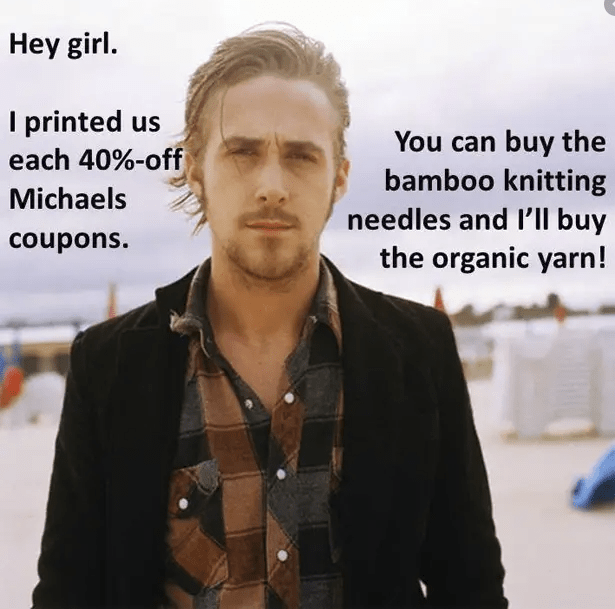
Please pin this post if you like it, and please join my email list!

